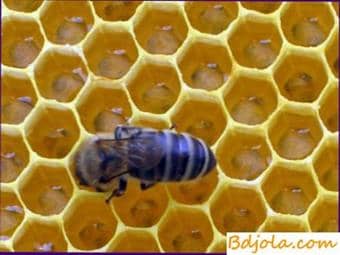Nectar toxicosis of bees

Nectar toxicosis is an infectious disease, mainly bee-gatherers, caused by poisonous nectar.
Causes of the disease. When collecting flowers, bees are poisoned by the poisonous nectar of some plants. Poisonous nectar is distinguished by the following honey-plants: Japanese Sophora (Sophora japonica), Ledum palust-ghe, Tulips (Corona imperialis), wrestler (Aconitum sep-tentrionale, A. excelsum), lance peel (Senecio sagittatus), various species of delphinium Del-finium, Euphorbia marginata, Ve-ratrum album, V. nigrum, Thymus serpyllum, Onion, Aesculus hippocastanum, Andromeda japonica, A. polifolia, A. caly-culata), crow’s eye (Paris quadri), sapinodus (Sapino-dus emorgynatus), cornflower (Centaurea scabiosa), Carduus nutans, Scabiosa succisa, oleander (Nerium oleander), golden rain (Cytisus laburnum) , wolfberry (Daphne pontica), boxwood (Buxus s emper-virens).
Their toxicity depends on the presence in the roots, stems, leaves and nectar of various alkaloids, glucosides and saponins. Poisonous substances with nectar are absorbed by the walls of the intestine into the hemolymph and cause acute poisoning of the type of intoxication. Often poisoning is temporary. Sick bees can recover.
Course of the disease. Usually, the release of poisonous nectar occurs after unfavorable weather. The development of the disease can be acute, in other cases – slow. With acute development of the disease, bee pickers get sick and die right away, not having time to bring nectar to the hive. In these cases, a small number of bee-scouts die. In general, the family does not suffer.
With a slow development of the disease, bees-scouts manage to bring nectar into the beehive and signal to other bees the place of bribe. Then a lot of other bee-gatherers are sent to this honey-plant, bringing poisonous honey to the beehive, which serves as a source of poisoning of a large number of intestine bees
The disease occurs in late May or early June and lasts 15-25 days. The development of the disease is promoted by cold snap, rains, drought and other factors that adversely affect honey gathering. With the advent of good honey collection, bees are converted to visit poisonous plants and the disease stops.
Symptoms of the disease. It manifests itself earlier in bees-gatherers. Young bees and drones get sick less often. Ill bees and dead bees can be found near those plants from which they collected poisonous nectar, on the way to the apiary, on its territory, near the hives and inside them. Ill bees lose their ability to fly.
On the ground, their behavior at first can be agitated, then oppressed. Musculature is quickly affected, and paralysis of wings, legs, antennae, and abdomen occurs. However, bees for a long time retain signs of life, occasionally shuddering all over the body or limbs. Such a state does not always end in ruin. Some bees recover during the first 24 hours.
The poisonous nectar of different plant species causes different symptoms in diseased bees. Thus, when the alkaloid is poisoned with bleached, there is a strong excitation of bees. They attack people and animals, they come to a state of “rabies”. The disease lasts 15-20 days. In 7-10 days after the poisoning begins, mass death of bees occurs, until the families die completely.
From the nectar of rhododendron (Rhododendron ponticum), flight bees are killed first, then young hive, fetal uterus, larvae (workers, uterine, drone). Later, the sealed brood dies out.
The greatest loss is in strong families. In individual families only uterus and uterine larvae perish. In patients with bees, the rectum is stretched, overflowing with a light yellow transparent liquid which, when fed to bees, is poisonous. When studying the liquid under a microscope, rhododendron pollen was detected.
Patients of bees and larvae from open cells of the bee are quickly thrown out of the hive. Larvae in the sealed cells turn yellow, darken; The bees gradually release them and discard them.
Diagnosis. With nectar toxicosis, the disease manifests itself quickly, bees-pickers are affected. They show signs of life for a long time. Many of them are recovering. There are no noticeable pathologic changes in the intestine. Other diseases of bees are excluded.
According to the structure of the pollen, which is in nectar or honey, the species of the poisonous plant is determined.
Prevention. On the reserve sites sow faeces, cucumber grass, mustard and other mead so that their bloom coincides with the time when in this area there is no bribe.
Control measures. Bees are fed with 30-50% sugar syrup. Already on the second day after feeding, the disease disappears. They also apply bees to non-poisonous vegetation.
In order to preserve a part of the diseased bees (when they get sick in large numbers) they are collected from the territory of the apiary, scattered in a thin layer into empty hives and placed in a warm room. Bees quickly restore their strength at a temperature of 20-25 њ.
Nectar toxicosis of bees
